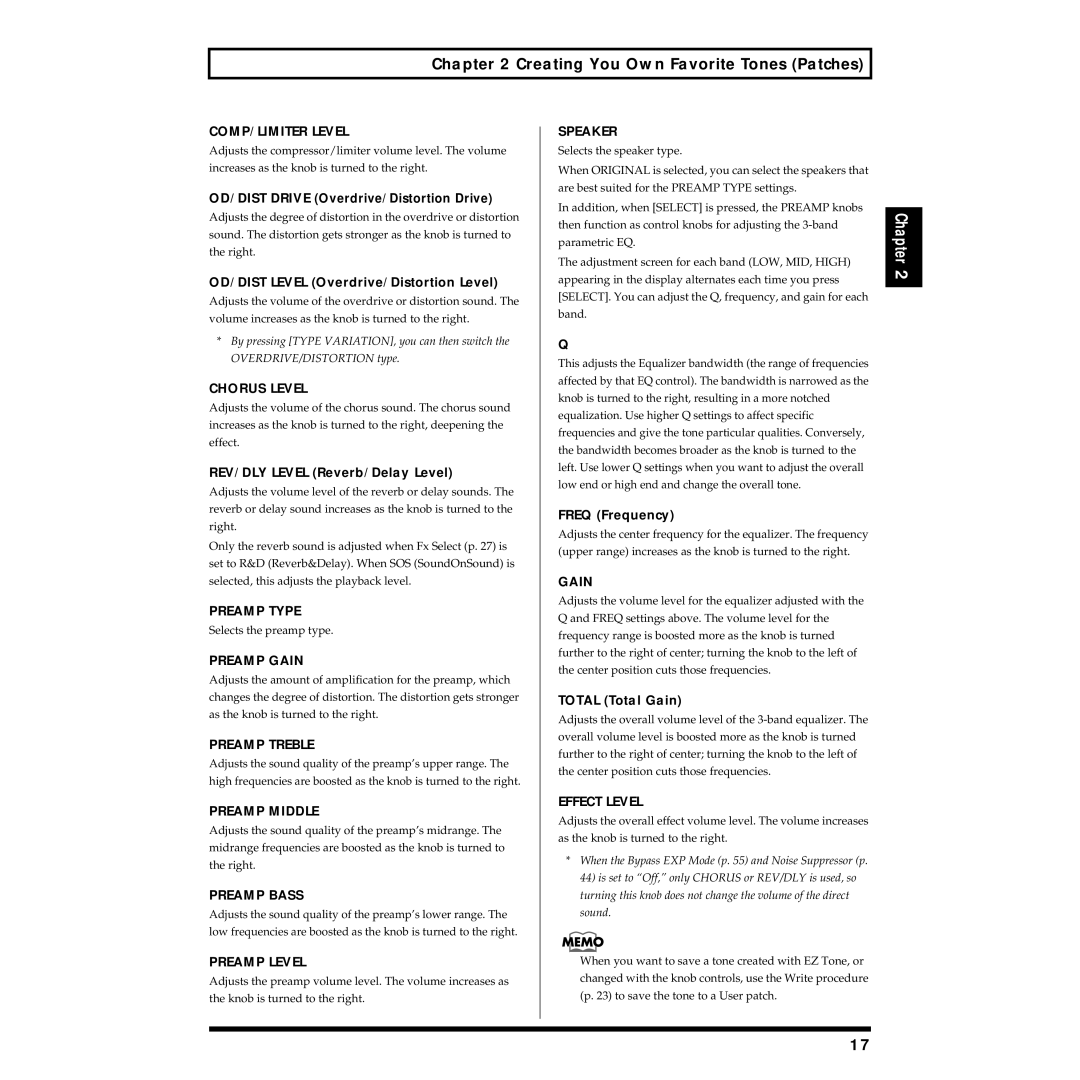
Chapter 2 Creating You Own Favorite Tones (Patches)
COMP/LIMITER LEVEL
Adjusts the compressor/limiter volume level. The volume
increases as the knob is turned to the right.
OD/DIST DRIVE (Overdrive/Distortion Drive)
Adjusts the degree of distortion in the overdrive or distortion sound. The distortion gets stronger as the knob is turned to the right.
OD/DIST LEVEL (Overdrive/Distortion Level)
Adjusts the volume of the overdrive or distortion sound. The volume increases as the knob is turned to the right.
*By pressing [TYPE VARIATION], you can then switch the OVERDRIVE/DISTORTION type.
CHORUS LEVEL
Adjusts the volume of the chorus sound. The chorus sound increases as the knob is turned to the right, deepening the effect.
REV/DLY LEVEL (Reverb/Delay Level)
Adjusts the volume level of the reverb or delay sounds. The reverb or delay sound increases as the knob is turned to the right.
Only the reverb sound is adjusted when Fx Select (p. 27) is set to R&D (Reverb&Delay). When SOS (SoundOnSound) is selected, this adjusts the playback level.
PREAMP TYPE
Selects the preamp type.
PREAMP GAIN
Adjusts the amount of amplification for the preamp, which changes the degree of distortion. The distortion gets stronger as the knob is turned to the right.
PREAMP TREBLE
Adjusts the sound quality of the preamp’s upper range. The high frequencies are boosted as the knob is turned to the right.
PREAMP MIDDLE
Adjusts the sound quality of the preamp’s midrange. The midrange frequencies are boosted as the knob is turned to the right.
PREAMP BASS
Adjusts the sound quality of the preamp’s lower range. The low frequencies are boosted as the knob is turned to the right.
PREAMP LEVEL
Adjusts the preamp volume level. The volume increases as the knob is turned to the right.
SPEAKER
Selects the speaker type.
When ORIGINAL is selected, you can select the speakers that are best suited for the PREAMP TYPE settings.
In addition, when [SELECT] is pressed, the PREAMP knobs then function as control knobs for adjusting the
The adjustment screen for each band (LOW, MID, HIGH) appearing in the display alternates each time you press [SELECT]. You can adjust the Q, frequency, and gain for each band.
Q
This adjusts the Equalizer bandwidth (the range of frequencies affected by that EQ control). The bandwidth is narrowed as the knob is turned to the right, resulting in a more notched equalization. Use higher Q settings to affect specific frequencies and give the tone particular qualities. Conversely, the bandwidth becomes broader as the knob is turned to the left. Use lower Q settings when you want to adjust the overall low end or high end and change the overall tone.
FREQ (Frequency)
Adjusts the center frequency for the equalizer. The frequency (upper range) increases as the knob is turned to the right.
GAIN
Adjusts the volume level for the equalizer adjusted with the Q and FREQ settings above. The volume level for the frequency range is boosted more as the knob is turned further to the right of center; turning the knob to the left of the center position cuts those frequencies.
TOTAL (Total Gain)
Adjusts the overall volume level of the
EFFECT LEVEL
Adjusts the overall effect volume level. The volume increases as the knob is turned to the right.
*When the Bypass EXP Mode (p. 55) and Noise Suppressor (p. 44) is set to “Off,” only CHORUS or REV/DLY is used, so turning this knob does not change the volume of the direct sound.
When you want to save a tone created with EZ Tone, or changed with the knob controls, use the Write procedure (p. 23) to save the tone to a User patch.
Chapter 2
17
